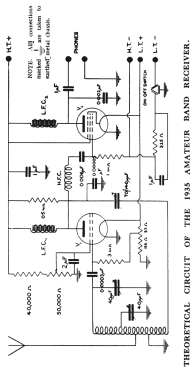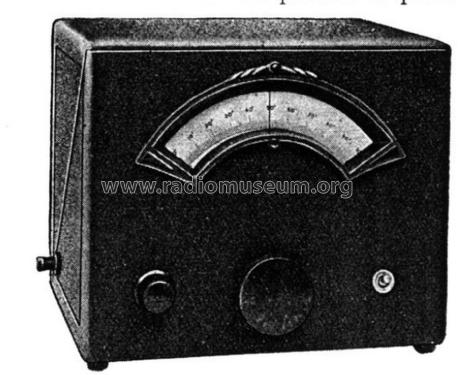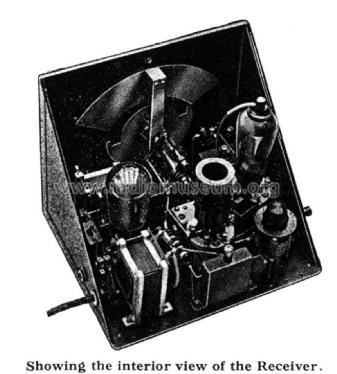Amateur Bands Two 1935
Eddystone (Brand), Stratton and Co., Ltd., Eddystone Radio Ltd.; Birmingham
- País
- Gran Bretaña (GB)
- Fabricante / Marca
- Eddystone (Brand), Stratton and Co., Ltd., Eddystone Radio Ltd.; Birmingham
- Año
- 1935
- Categoría
- Kit (Partes con instruciones) o Solo Instrucciones
- Radiomuseum.org ID
- 355328
Haga clic en la miniatura esquemática para solicitarlo como documento gratuito.
- Numero de valvulas
- 2
- Principio principal
- RFS con reacción (regenerativo)
- Gama de ondas
- OM y OC
- Tensión de funcionamiento
- Baterías recargables o pilas
- Altavoz
- - Este modelo usa amplificador externo de B.F.
- Material
- Metálico
- de Radiomuseum.org
- Modelo: Amateur Bands Two [1935] - Eddystone Brand, Stratton and
- Forma
- Sobremesa de cualquier forma, detalles no conocidos.
- Anotaciones
-
Amateur Bands Two Receiver: 1935 Kitset
Design Philosophy:
This receiver prioritizes high efficiency for amateur bands using a minimal number of valves. The goal is to achieve high amplification with a quiet background compared to a multi-valve superheterodyne receiver. Selectivity is a primary concern, and the 1935 design boasts significant improvement over the 1932 model due to a new tuning coil system.Circuitry:
- Detector: A screened-grid valve is employed as the detector. High-impedance choke coupling maximizes the valve's high amplification potential. A low-frequency transformer wouldn't be suitable due to the valve's high impedance. Resistance coupling calculated for impedance matching results in a significant voltage drop, causing operational instability and requiring a higher operating voltage.
- Output Valve: A steep-slope pentode serves as the output valve, again offering high amplification.
- High-Frequency Choke Placement: The high-frequency choke is located in series with the grid leak to the second valve instead of the high-impedance choke. This placement offers improved results.
- Grid Bias: The grid leak connects to a detector bias resistor, providing the grid with a slightly positive bias. This configuration proved superior to connecting to either L.T. positive or L.T. negative. Automatic grid bias and a "drop-fed" high-tension supply are additional refinements.
Coils:
- The receiver utilizes specially manufactured 5-pin coils designed for amateur wavebands.
- Aerial Coupling: The aerial feeds into a tapping point positioned well down the coil, which is tuned by a 35 mmF capacitor.
- Band Spreading: An additional band-spreading capacitor is included, tapped across a portion of the coil. This capacitor spreads the amateur bands over a larger dial range for finer tuning.
- Reaction: The lower end of the coil winding is used for reaction purposes.
Tuning and Reaction Control:
- Tuning is exceptionally sharp. By adjusting the band-spreading capacitor, the amateur bands are spread over practically the entire dial.
- Reaction Control: A unique method for reaction control was implemented. A pre-set capacitor and reaction coil, similar to the Reinartz principle, provide a set amount of reaction. Final adjustments are made using a potentiometer controlling the high tension voltage to the detector valve's screened grid. This method ensures no wavelength shift occurs during reaction adjustment, resulting in smooth control up to the maximum point.
Hand Capacity Reduction:
- Hand capacity can negatively impact performance in an efficient amateur receiver. The "Amateur Bands" Two design completely eliminates this issue, even when using headphones. Users can practically touch the metal chassis while wearing headphones without affecting the received signal.
- Mencionado en
- - - Manufacturers Literature (Eddystone Shortwave Manual No. 2, 1935, Pages 12 -14.)
- Autor
- Modelo creado por Gary Cowans. Ver en "Modificar Ficha" los participantes posteriores.
- Otros modelos
-
Donde encontrará 255 modelos, 125 con imágenes y 46 con esquemas.
Ir al listado general de Eddystone (Brand), Stratton and Co., Ltd., Eddystone Radio Ltd.; Birmingham



